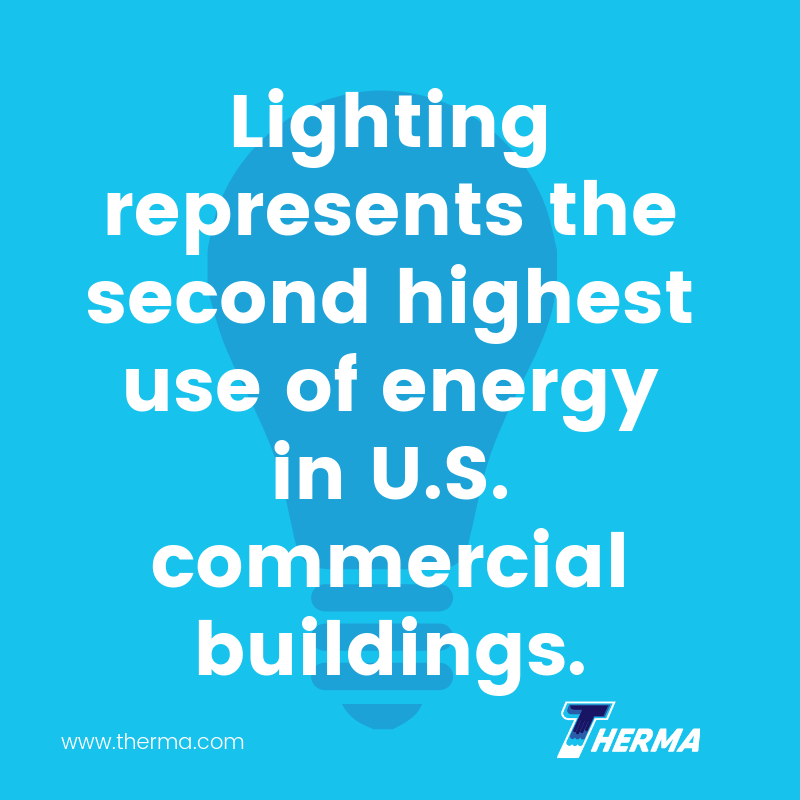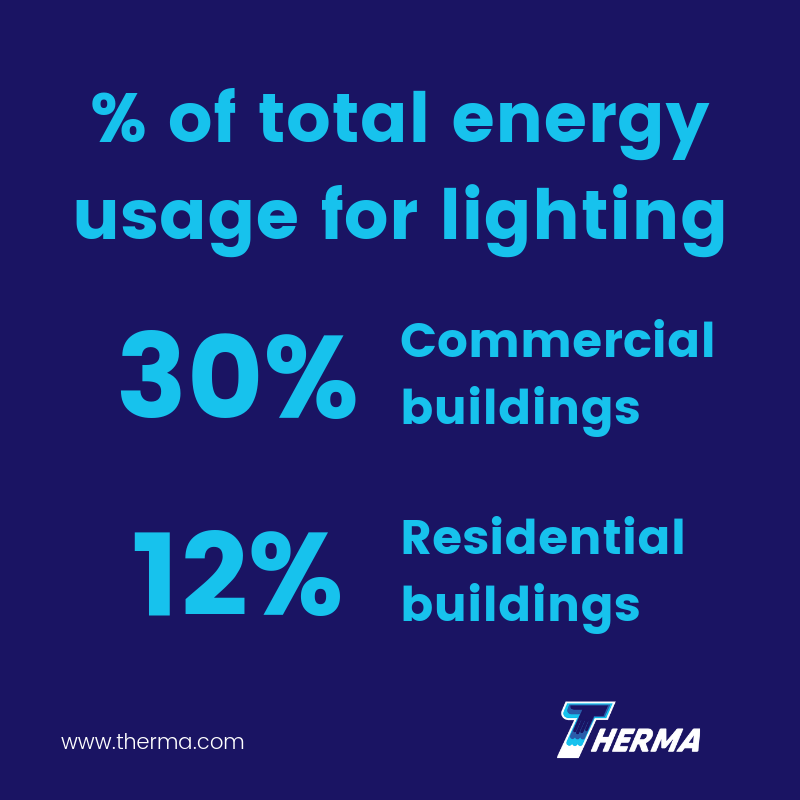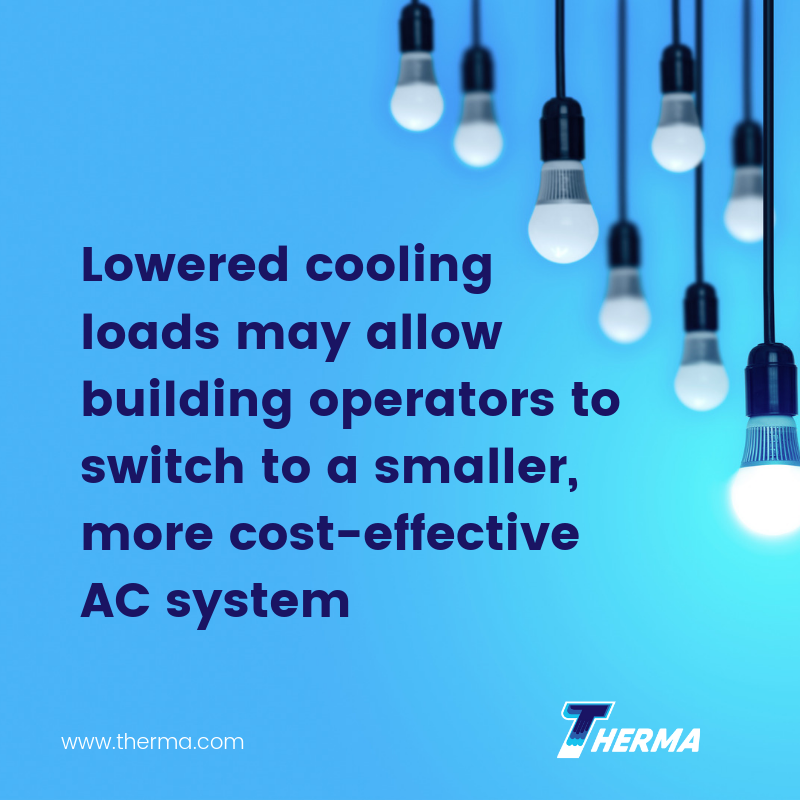By Erica Corder
Lighting is one of the largest sources of energy consumption in commerce. In fact, the most recent data from the Commercial Buildings Energy Consumption Survey shows that lighting represents the second highest use of energy in U.S. commercial buildings.
 However, advancements in lighting technology, such as light emitting diodes (LEDs), can significantly reduce energy use compared to commonly-used fluorescent bulbs or the far-worse incandescent bulbs, which are so ineffective that they are no longer produced.
However, advancements in lighting technology, such as light emitting diodes (LEDs), can significantly reduce energy use compared to commonly-used fluorescent bulbs or the far-worse incandescent bulbs, which are so ineffective that they are no longer produced.
Not only do upgrades to lighting systems lower energy consumption, they also reduce the amount of heat emitted by lights. This in turn can have a dramatic effect on cooling loads. For commercial buildings with higher lighting needs, lighting’s effect on cooling loads is important to understand since it can significantly influence the annual costs of HVAC use and maintenance over time.
How Heat Gain From Lighting Affects Cooling Loads
Like sunlight and appliances, lighting systems contribute to a building’s heat gain, although the amounts of heat gain vary based on bulb type.
Commercial buildings in particular experience a greater Lighting Power Density (LPD) to ensure optimal lighting conditions for business activities: Studies show that 30% of an office’s electricity consumption is from lighting, compared to approximately 12% in residential buildings.

Air conditioning systems in commercial buildings therefore have to work harder because of the additional heat gain from lighting. This can be so significant that reducing the annual lighting energy use can also result in reductions of 40% or more in HVAC energy for commercial buildings in which annual cooling loads surpass heating loads.
The returns vary based on factors like building characteristics, the climate of the building’s location, and the heating and cooling load size. Take these factors into account when considering changes to lighting.
Considering Lighting in HVAC Load Calculations
Generally, lighting systems are one of the largest sources of heat gain in commercial buildings. While this means inefficient lighting will increase cooling loads, the heat gain from lighting can actually reduce heating loads.
However, using lighting for heat gain renders lighting fixtures similar to electric resistance heaters, which are among the most inefficient and expensive heating methods. This means that even if a building requires heating year-round, inefficient lighting measures are still more costly to the bottom line.
Meanwhile, reducing lighting loads will lower electricity costs and heat gain while reducing the cooling load during peak load times. This reduction in the cooling load could lead to excess capacity for future cooling load requirements and prolong the lifespan of the HVAC system, leading to further cost savings.
On all counts, choosing more efficient lighting results in net positive returns in energy efficiency and electricity bill savings, but the degree of cost savings varies.
Generally, high-rise buildings with high internal loads stand to gain the most by switching to more energy-efficient lights. Since these buildings already experience high cooling loads to maintain comfortable thermal conditions, every kWh of reduction in annual lighting energy returns an additional 0.4 kWh annual reduction in HVAC energy.
Buildings that are smaller, meanwhile, may see a net negative impact on HVAC loads, particularly if located in colder climates where heating loads are higher. Still, the electricity cost savings from upgrades to a lighting system outweigh the higher heating costs. Additionally, lowered cooling loads may allow building operators to switch to a smaller, more cost-effective AC system.
How a Lighting Retrofit Benefits the Bottom Line
With all of this in mind, how can you calculate the cost savings of a lighting retrofit for your building?
You can run simulations or do quick math to calculate the change in cost per bulb. To do the latter, start by calculating the annual energy savings of your lighting, estimating the months of cooling required as a percentage of a year. In addition, track down your electricity rate.
You’ll then figure out how much energy is required for cooling to offset the retrofit lighting, given that the American Society of Heating, Refrigeration and Air Conditioning Engineers (ASHRAE) provides a rule of thumb that every 100 watts of lighting requires 30 to 35 watts of cooling. Multiply your energy savings, the percentage of a year that cooling is required, and the ASHRAE rule of thumb (you can use 33, the average between 30 to 35).
That figure will show you the electricity savings for your HVAC cooling load. To get a dollar amount per bulb, multiply this by your electricity rate. You can then multiply this figure again by the number of bulbs being replaced in your lighting retrofit to see the cost savings for your HVAC annually.
Based on the math, reducing the energy savings of your lighting will result in a net positive energy savings and is a simple way to reduce your cooling loads — saving you money in the long run.
References:
- https://www.eia.gov/consumption/commercial/reports/2012/lighting/
- https://www.energy.gov/energysaver/save-electricity-and-fuel/lighting-choices-save-you-money
- https://www.e3s-conferences.org/articles/e3sconf/pdf/2017/07/e3sconf_eems2017_01024.pdf
- https://www.archtoolbox.com/materials-systems/electrical/recommended-lighting-levels-in-buildings.html
- https://www.energystar.gov/sites/default/files/buildings/tools/EPA_BUM_CH6_Lighting.pdf
- https://www.fs.fed.us/t-d/pubs/htmlpubs/htm01712310/heating.htm
- https://www.csemag.com/articles/factoring-lighting-into-cooling-loads/
- https://insights.regencylighting.com/how-to-calculate-hvac-energy-savings-from-lighting-step-by-step-guide
- https://www.bulbs.com/learning/energycalc.aspx
- https://openei.org/wiki/Utility_Rate_Database
- https://www.ashrae.org/








